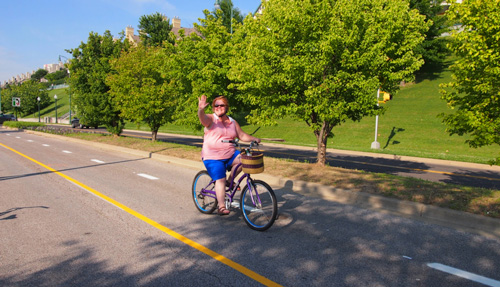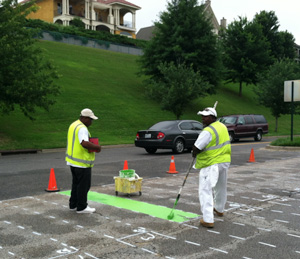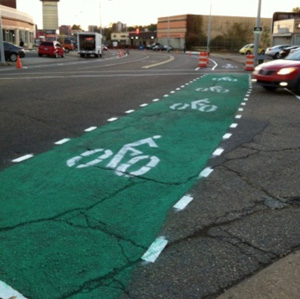DISCOVER YOUR LOCAL BICYCLING COMMUNITY
Find local advocacy groups, bike shops, instructors, clubs, classes and more!
How To: Innovative Infrastructure
This blog is cross-posted from the Advocacy Advance blog, and is authored by Christy Kwan.
Advocacy Advance recently released its latest report, “How Communities are Paying for Innovative On-Street Bicycle Infrastructure.” The report provides examples of how communities across the country are paying for separated bicycle infrastructure. Just like how communities are paying for other important civic infrastructure, communities are using a combination of federal, state, local/regional, and private sources of funds.
In conjunction with the report’s release, Advocacy Advance held a webinar with the report’s author, Darren Flusche, Policy Director at the League of American Bicyclists; Randy Neufeld, Director at SRAM Cycling Fund; and Kyle Wagenschutz, Bicycle/Pedestrian Coordinator at the City of Memphis, TN.
 
Watch the webinar recording and download the combined slides from all panelists (PDF).
Examples from Memphis

The City of Memphis, one of the cities selected in the first round of the Green Lane Project, recently added more than 70 miles of bike lanes and trails all over the city. With a previous budget of $0, the city’s Bicycle/Pedestrian Coordinator uses creative thinking to transform Memphis into a great cycling city on a tight budget. The city has identified 140 miles of new bike lanes and trails – including 22 miles of protected bike lanes – over the next three years.
Whether you’re an advocate looking for creative examples of how other cities have done it, or a transportation staff member at a MPO on a shoestring budget, here are three tips from Memphis to get innovative bicycle infrastructure started in your community.
 1. Don’t be afraid to ask
1. Don’t be afraid to ask
When the City learned that a state route on the edge of Downtown was going to be repaved, the Bike/Ped Coordinator asked if protected bike lanes could be included in the project. Just by asking, the City learned that state Department of Transportation was open to including bike lanes, but stated that any additional costs above the repaving project (i.e., the additional green pavement and bollards) would need to be covered other sources of funding. The Bike/Ped Coordinator placed a few more additional calls, and learned that Highway Safety Improvement Program (HSIP) dollars were applicable, and applied and received funding to install the additional protected bike lanes.
If you’re agency staff, you’ve probably noticed that there’s no shortage of vendors looking to sell products to cities. Don’t be afraid to ask vendors to come to town to demonstrate the project and ease of application or installation. Most vendors are willing to provide a small amount of materials. These demonstration projects could potentially be combined into a demonstration project for your community
2. Convince MPO staff to prioritize bicycle improvements
Start at the local level and ensure that your MPO prioritizes bicycle improvements. The Memphis Area MPO reset its ranking criteria for funding projects to include bicycle improvements. By prioritizing these improvements, jurisdictions responded to win the most amount of points available and 80% of submitted projects contained a bicycle improvement. In the ranking criteria for Surface Transportation Project (STP) funds, a separated pathway for people who bike and walk receives the highest number of points.
 3. Be creative and resourceful
3. Be creative and resourceful
It’s no quick work to access federal funds for bicycling projects. Agency staff can apply and wait for federal funds, but sometimes it can be a test of patience for those funds to arrive. So how are cities able to move forward knowing that the federal process can sometimes take years? In one instance, Memphis used acrowdsourcing website, In Our Backyard, to raise over $68,000 for a two-way cycle track.
If there’s political momentum and demand from citizens for bicycle infrastructure, agency staff should still move through the federal process for funds, but utilize low-cost mechanisms in the meantime to make short-term changes to the street.
Low-cost mechanisms can include utilizing left over building materials or utilizing a combination of vendor samples. In Memphis, an aerosol spray can of green spray chalk was used for a temporary green lane on Cleveland Street. On Mississippi Boulevard, white traffic paint was tinted another color by a local paint store. These quick, short-term changes gets citizens to use the infrastructure, but also gets drivers and other roadway users to experience the new configuration. By doing quick pilot programs, agency staff can work through the public dialogue to review the potential impacts. By the time federal money arrives, a robust public dialogue has taken place versus talking about theoretical designs that all users are unsure about.
For more information about bicycle and walking efforts in Memphis, please visit bikepedmemphis.com. Also check out our resources on federal funding programs, use our interactive Find It, Fund It! tool, and learn about state revenue sources for biking and walking.
Photos courtesy of Kyle Wagenschutz/ City of Memphis.